In Brief. When we think about Northwest Coast Art and Vancouver, we are naturally drawn to what is considered by many to be the most important (I think I earlier said “almost-iconic”) work of Haida artist Bill Reid.
I’m not sure – and probably not enough of an expert in the study of this art form – to form a judgement. But from a personal point of view, I very much like Reid’s The Raven and the First Men. Its presentation at the University of British Columbia Museum of Anthropology is nothing short of breath-taking.
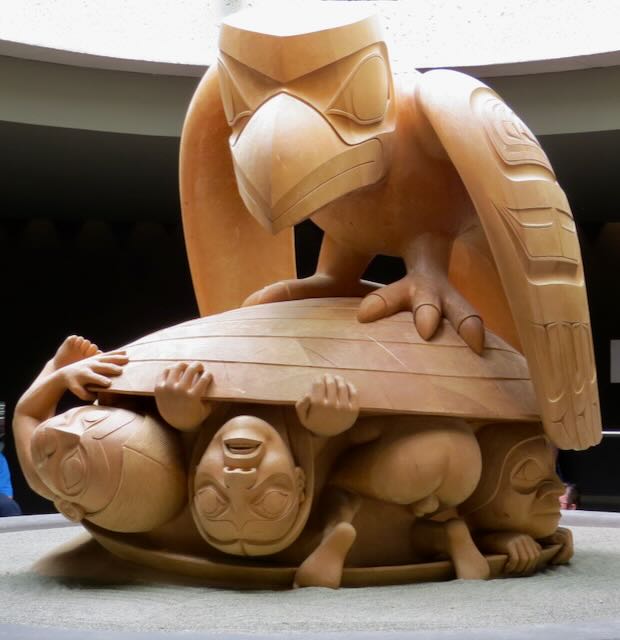
Andrew and I had seen this important work on a previous visit to Vancouver, and we were impressed then as well. So this trip, with our friend Kevin Manion (introduced in an earlier post), we were once again able to enjoy this spectacular sculpture, taking a special day to visit the University of British Columbia Museum of Anthropology. It was a visit not to be forgotten.
And at MOA, of course, we gave ourselves plenty of time to enjoy again the magnificent centerpiece of the museum’s collection, which Reid first created in 1970. And we would see it again – in different forms and styles – in our later visit downtown to the Bill Reid Gallery of Northwest Coast Art.
The Raven and the First Men
A particular creation myth was immortalized in this work and – as some critics have described – the work as a result has “taken its place as a beloved cultural beacon in the Museum of Anthropology.” The narrative tells about the Raven (“Xhuuya”), a well-known Haida Trickster who created the archipelago of Haida Gwaii and its first humans. Naturally within the Northwest Ocean tribes and First Peoples, many versions of this creation story have been passed down, and Reid’s version is based on how the Raven releases humans from a clamshell found on the beach. Not surprisingly – as we learn more about Reid – he takes a little creative flexibility, stating that it was “a version of the Raven myth for today, not for the time when it was created.” He saw the Raven as a “completely self-centered, uninvolved bringer of change,” who “through inadvertence and accident” represented the individualistic and diverse society of the current day, long before our later societies even existed.
Here are two other views – from different angles – of this remarkable work of art. Reid gave the sculpture – carved from a single block of laminated yellow cedar – its name, calling it The Raven and the First Men. As noted, it represents the Haida creation myth of the origin of mankind, and Reid understood the special significance of this (or any) story about how humanity was created.
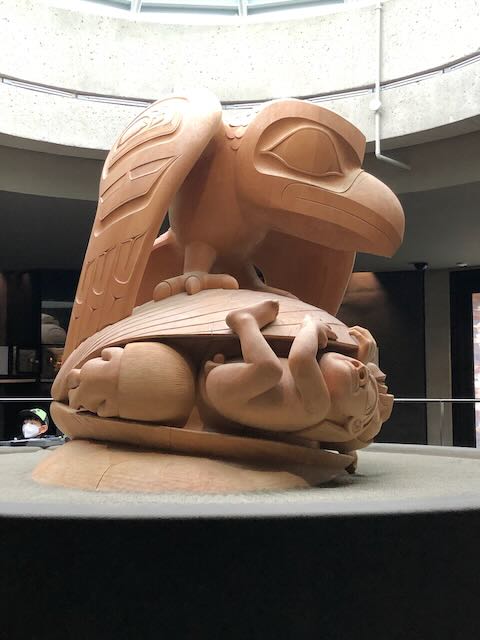
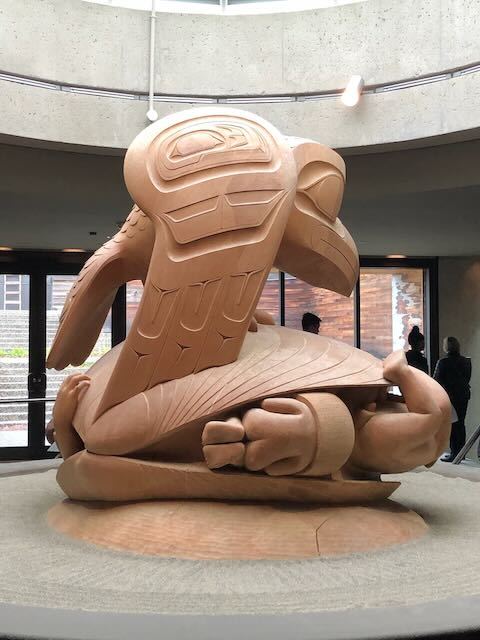
The following description, which Reid wrote when the work was installed in 1980, is posted at MOA:
“The great flood, which had covered the earth for so long, had at last receded and the sand of Rose Spit, Haida Gwaii, lay dry. Raven walked along the sand, eyes and ears alert for any unusual sight or sound to break the monotony. A flash of white caught his eye and there, right at his foot, half buried in the sand, was a gigantic clamshell. He looked more closely and saw that the shell was full of little creatures cowering in terror in his enormous shadow. He leaned his great head close and, with his smooth trickster’s tongue, coaxed and cajoled and coerced them to come out and play in his wonderful new shiny world. These little creatures were the original Haidas, the first humans.”
The MOA signage continues:
Haida artist Bill Reid first interpreted this origin story in a small boxwood carving. The Raven Discovering Mankind in a Clamshell in 1970 (displayed in a wall case in this gallery). Ten years later, he completed the monumental sculpture of laminated yellow cedar, The Raven and the First Men.
This is the first large, modern sculpture by a Northwest Coast First Nations artist to depart from the tradition of totem pole or mortuary monument carving. Here, Reid has blended Haida form and mythic content with Western naturalism, bringing expressiveness and movement to the raven and human forms.
Many people helped in the realization of this work. It was commissioned by Walter and Marianne Koerner of Vancouver. Sculptors George Norris, Guujaaw, George Rammell, Jim Hart, and Reg Davidson all participated with Bill Reid in various phases of the carving.
The Raven and the First Men was created over a period of several years, and unveiled by His Royal Highness The Prince of Wales on April 1, 1980. It was celebrated on June 5, 1980 by the Haida people of Haida Gwaii (the Queen Charlotte Islands).
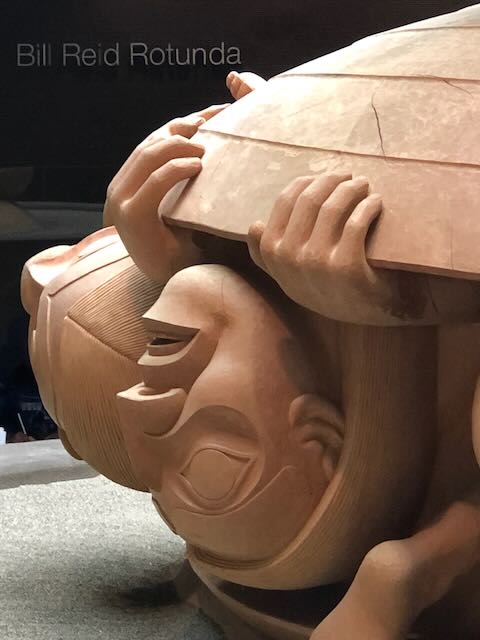

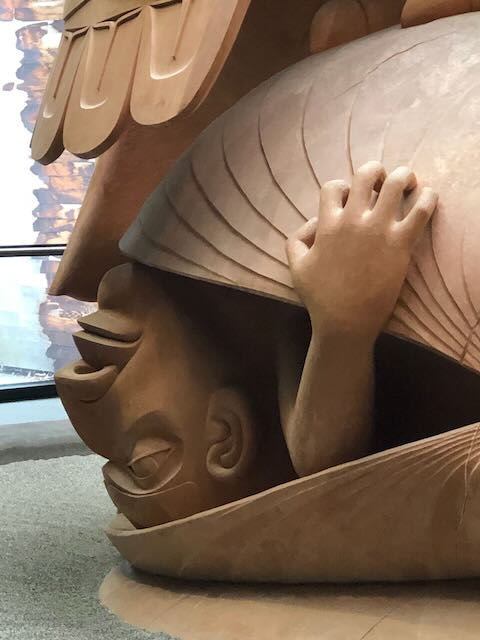
Finally, the small boxwood carving referred to above, installed at MOA in 1970, ten years before Reid completed the monumental final version (apologies for the not-so-good photograph – we didn’t have our professional photographers with us – just joking – and the rainy-day, late-afternoon light worked against us!).
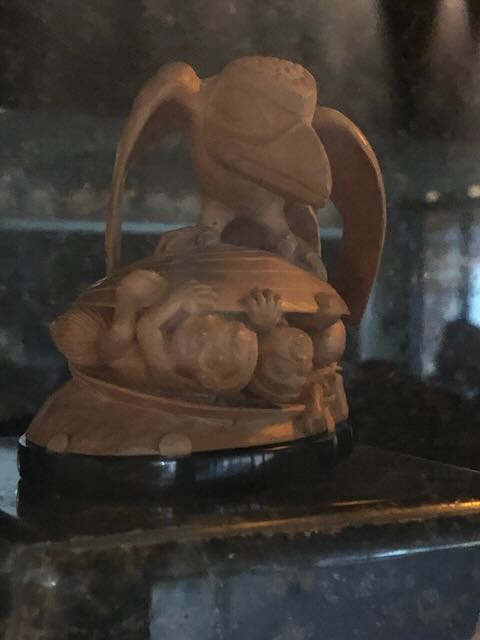
Leave a Reply